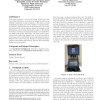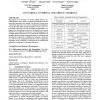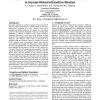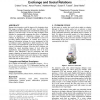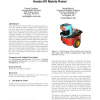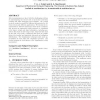HRI
2006
ACM
14 years 9 months ago
2006
ACM
This paper presents a robot search task (social tag) that uses social interaction, in the form of asking for help, as an integral component of task completion. We define socially...
HRI
2006
ACM
14 years 9 months ago
2006
ACM
HRI
2006
ACM
14 years 9 months ago
2006
ACM
The purpose of our research is to develop lifelike behavior in a communication robot, which is expected to potentially make human-robot interaction more natural. Our previous rese...
HRI
2006
ACM
14 years 9 months ago
2006
ACM
This paper describes an extensive analysis of the comfort level data of 7 subjects with respect to 12 robot behaviours as part of a human-robot interaction trial. This includes ro...
HRI
2006
ACM
14 years 9 months ago
2006
ACM
We present a model of human-like reaching movements. This model is then used to give a humanoid robot the ability to imitate human reaching motions. It illustrates that having a r...
HRI
2006
ACM
14 years 9 months ago
2006
ACM
Human-robot interaction could be improved by designing robots that engage in adaptive dialogue with users. An adaptive robot could estimate the information needs of individuals an...
HRI
2006
ACM
14 years 9 months ago
2006
ACM
This paper examines human perceptions of humanoid robot behavior, specifically how perception is affected by variations in head tracking behavior under constant gestural behavior....
HRI
2006
ACM
14 years 9 months ago
2006
ACM
We present a method of grounded word learning that is powerful enough to learn the meanings of first and second person pronouns. The model uses the understood words in an utteran...
HRI
2006
ACM
14 years 9 months ago
2006
ACM
This paper presents results toward our ongoing research program into hands-off assistive human-robot interaction [6]. Our work has focused on applications of socially assistive r...
HRI
2006
ACM
14 years 9 months ago
2006
ACM
Robot programmers are faced with the challenging problem of understanding the robot’s view of its world, both when creating and when debugging robot software. As a result tools ...
